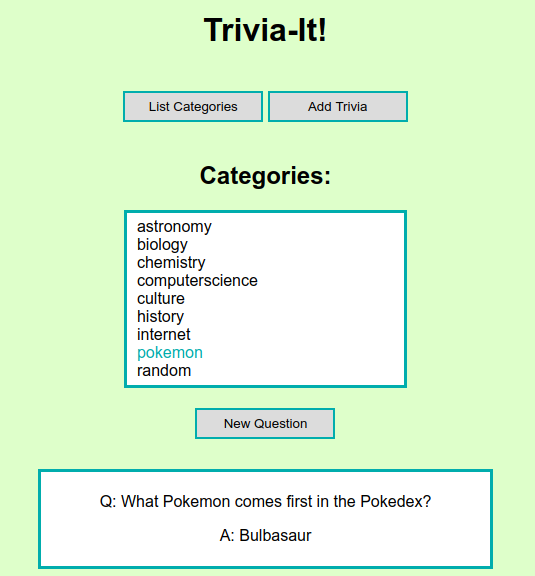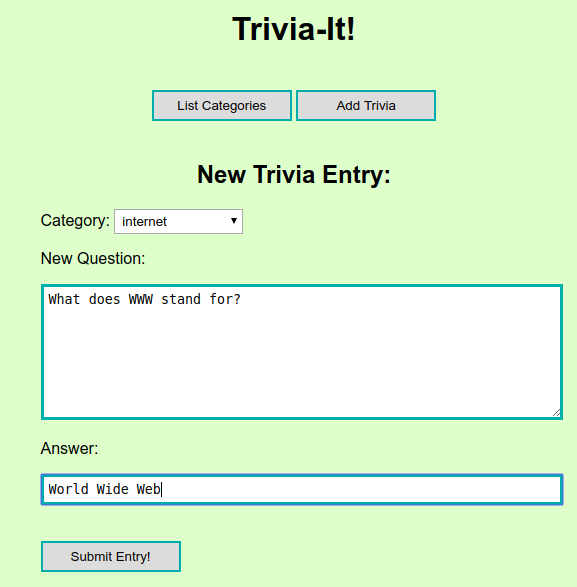CSE 154
Week 8 Section: Writing our own Trivia Web Service
Overview
In today's section, we will get more practice with PHP file i/o and write own own trivia web service. We will also practice making calls as a client to our web service using JS and AJAX.
Having written both the server-side and client-side programs for this website, this section will wrap up the course module on PHP web services!
First Things First, PHP Code Quality Review
First, we're going to review some PHP code quality guidelines for this course using an example of "poorly-implemented PHP code". The code is "externally correct", but has a variety of quality and documentation issues - many of these are common deductions in the PHP HW assignments.
You can find the source PHP code here. How many issues can you identify and explain as poor code quality?
- Annotated solution: annotated-bad-php-example.phps
- Full "good solution": fixed-php-example.phps
Exercise 1: Starting trivia.php
Now that we've reviewed some common PHP code quality issues, let's write a PHP web service! To get started:
-
Create a file called
trivia.php(remember to seterror_reporting(E_ALL)at the top!). - Download this trivia.zip folder of subdirectories containing trivia information for different topic categories.
-
Write initial PHP code to print out the contents in of a random file in the
triviafolder (recall theglobandscandirfunctions for accessing files in directories). You may also findarray_randuseful, as it selects a random index of a passed-in array. Also recallfile_get_contentsfor getting the contents of a file as a string. - Test your service by refreshing the page several times and making sure you are getting random questions and answers.
Exercise 2 Part I: Adding a 'mode' GET Parameter (mode=categories
Modify the trivia.php web service to take a required GET parameter called mode.
When the user passes in a mode value of categories,
the web service should output a plain text list of all of the subdirectory names in the
trivia/ folder.
astronomy
biology
chemistry
computerscience
culture
history
internet
pokemon
randomexample output (mode=categories)
Exercise 2 Part II: Adding a 'mode' GET Parameter (mode=category)
Next, add a check such that if mode is passed as category,
an optional name parameter can be passed to choose the category
name
to return the contents of a random file for that specific category instead of a random category.
If the name parameter is not passed, your web service should continue
to choose a random category as before.
Exercise 2 Part II: Error Handling
If the mode query parameter is missing or does not have a value of either categories or
category print out a 400 error message,
"Error: Please provide a mode of categories or category".
Otherwise, if the mode query parameter is passed with a value of
category and the optional query parameter name is passed a
value that does not correspond to a category directory in the trivia
directory, print out a 400 error message,
"Error: Unknown category name).
Exercise 3 Part I: Output JSON for Question Data
In this part of the exercise, we will practice outputting our data in a more
useful JSON format. Recall that JSON is much easier for clients to process
than plain text. First, we'll focus on changing our response when for
mode=category.
Any valid response for this mode should output the random question and answer in the JSON format displayed below (example for request to trivia.php?mode=category&name=pokemon):
{
"question" : "What Pokemon comes first in the Pokedex?",
"answer" : "Bulbasaur"
}output (JSON)
Exercise 3 Part II: Output JSON for Categories Data
Next, update your code for handing mode=categories to now output JSON data in the format
below:
{
"categories" : [
{ "astronomy" : 2},
{ "biology" : 4},
{ "computerscience" : 10},
{ "culture" : 5},
{ "history" : 8},
{ "internet" : 9},
{ "pokemon" : 8}
{ "random" : 3}
]
}example output (JSON)
The keys (categories) are the names of the folders in trivia directory.
The values are the number of files in each category folder.
Exercise 4: Using Our Web Service as a Client (trivia.js)
Next, we'll use a starting trivia.js that has functions provided to
switch between different views and display questions/answers for trivia. However,
this file is missing... trivia. Let's use our new trivia web service for it to fetch
trivia from!
Note: For now, ignore the "Add Trivia" button. In Exercise 5/6, you can handle POST requests to finish the "Add Trivia" feature for more practice with POST!

Exercise 4: Starter Files
In this part, we'll
focus just on using our GET parameters for the "List Categories" feature. Download
the starter HTML/CSS/JS here and make sure these are located in the same directory
as your trivia directory and trivia.php file.
Exercise 4 Part I: Listing Categories
The provided trivia.html
(styled with trivia.css) has
three main sections: #category-view, #question-area, and
#new-trivia-view.
When the page is initally loaded, a call is made to fetchCategories. Finish
this function skeleton found in trivia.js
to fetch from your
trivia.php to get the JSON response of all categories available
(mode=categories). Use the provided populateCategories
function upon a successful response in this fetch request.
Exercise 4 Part II: Showing Questions and Answers
Next, when a user clicks the "New Question" button, a call to showTrivia is
made from toggleQA. Finish this showTrivia function to make a request to
trivia.php every time it is called. Your trivia.php
should send back data for a trivia tidbit if implemented correctly in Exercise 3. Upon success, you can use
the provided displayQuestion function to show the new question data.
Exercise 5: Adding a POST Request (1/2)
Now, we'll get some more practice handlng a POST request from our PHP service. Recall that while GET requests are often used to "get" information from a web service, POST requests are often supported by web services to take a request from a client and update some information on the server (e.g. adding to .txt files).
We'll add support to our trivia.php web service to allow a client to add a
new question/answer entry to an existing category!
Exercise 5: Adding a POST Request (2/2)
Add a check to your PHP such that if no GET parameter of mode is passed,
three required POST parameters are checked:
category- name of category to add new q/a entry toquestion- new question to add for categoryanswer- answer text for new question
If any of these parameters are missing or the passed category does not correspond to a category folder, output a helpful 400 error message of your choice. Otherwise, write the necessary code to create a new text file (following naming conventions of the others) with the following format:
Q: <new-question>
A: <new-answer>contents of new text file
Upon success, your web service should print the following plaintext response:
New entry added for <category> category!plaintext response for POST request
Exercise 6: Back to JS: Fetching with a POST Request
Now that you've implemented POST request handling in your PHP, add features to make a
POST request in trivia.js when a the "Submit Entry!" button is clicked in
the "Add Trivia" view. Make sure to display a helpful message in the
#response paragraph if missing question text in
the textarea and a corresponding answer in the answer input box.
